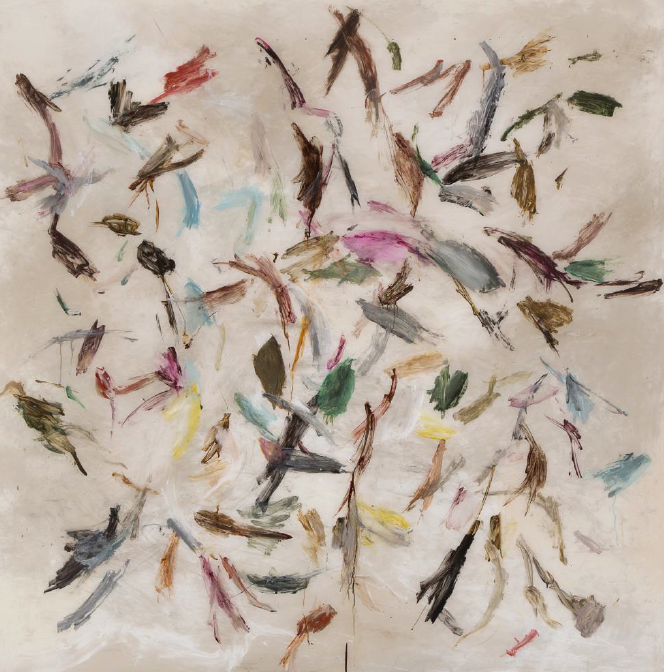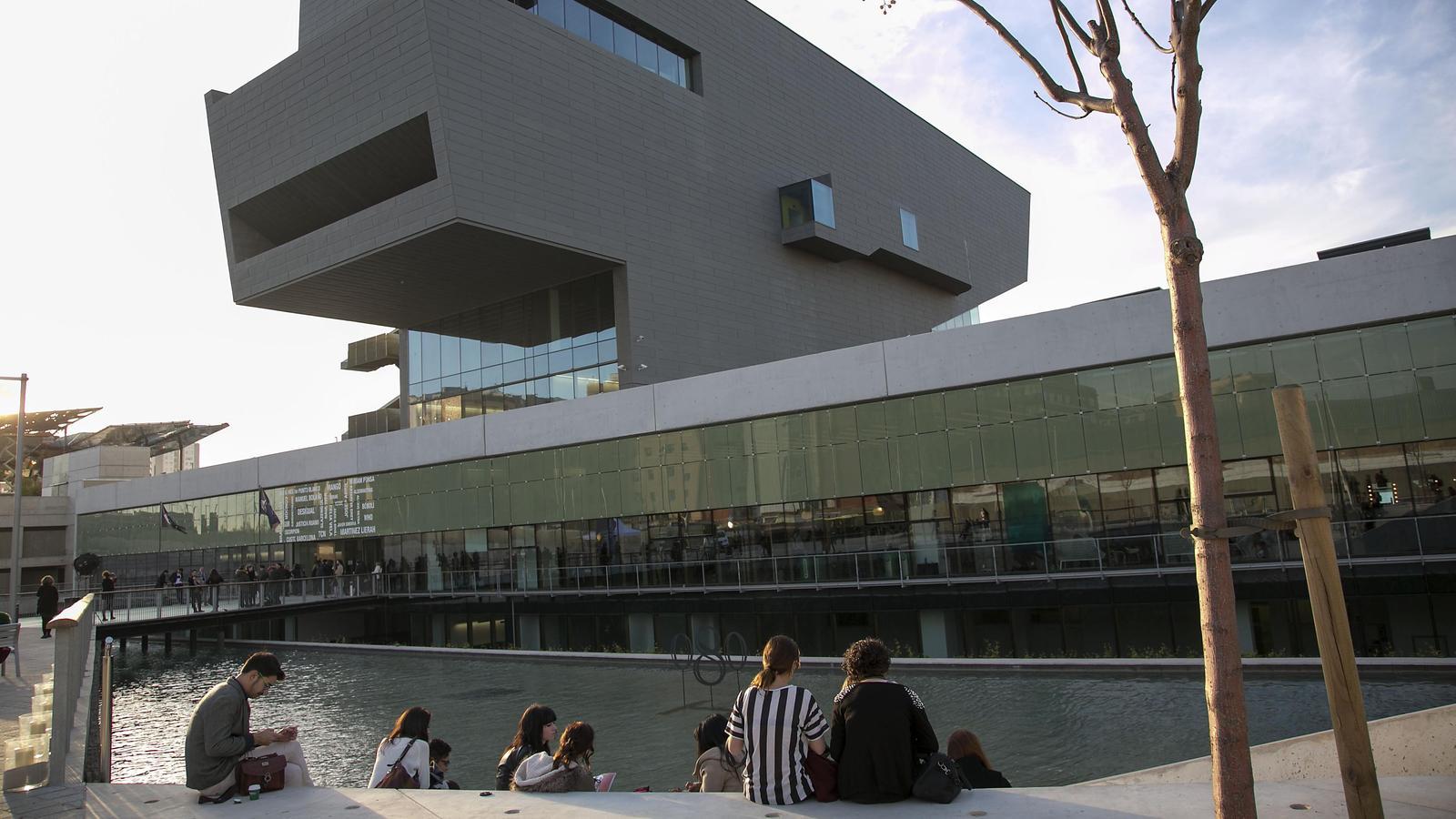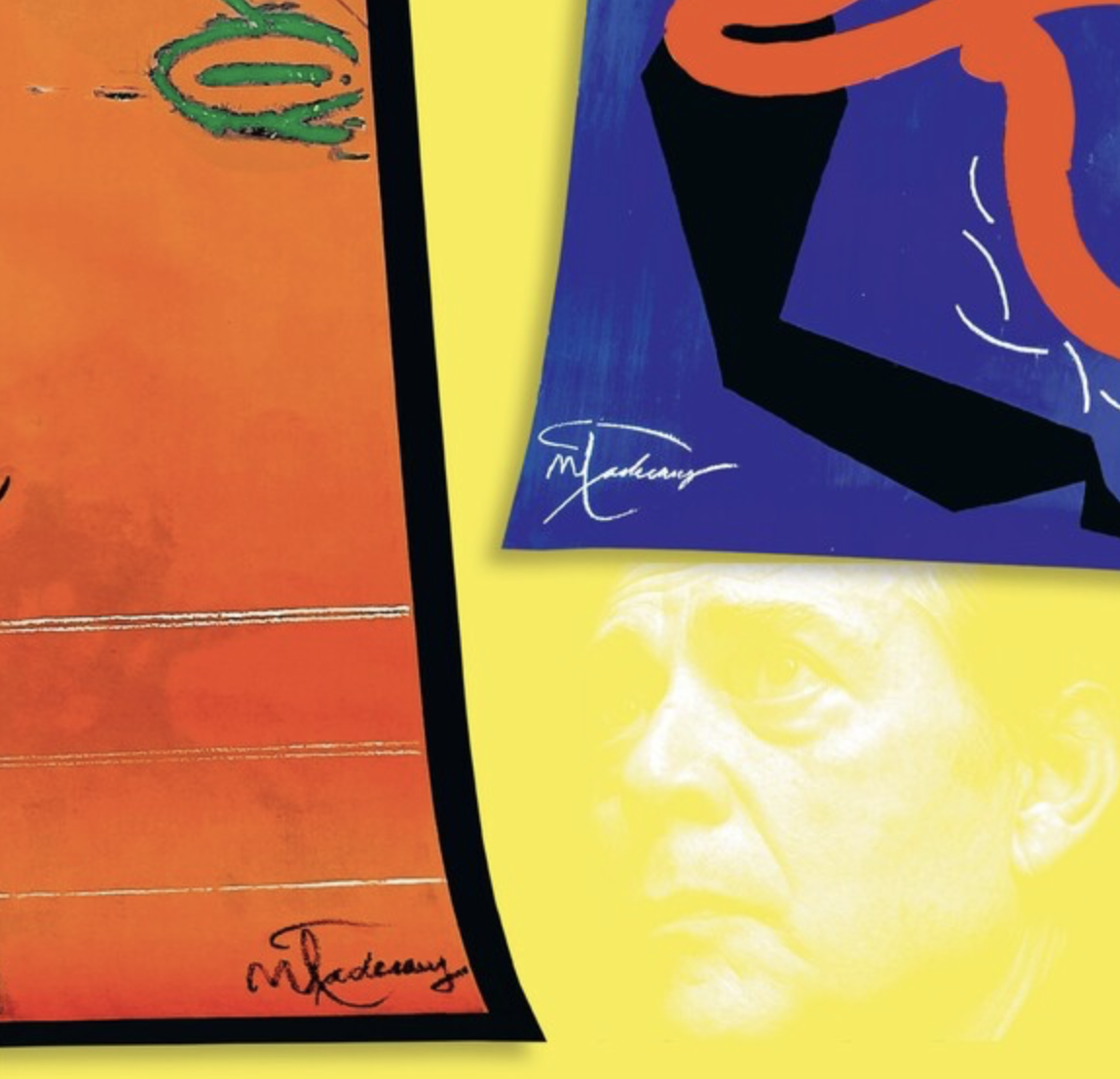Opinion
Schiaparelli: Shocking Surrealism
He introduced the collaborations between fashion and the world of art and his legacy is collected by Daniel Roseberry, who this June will open Paris Haute Couture week
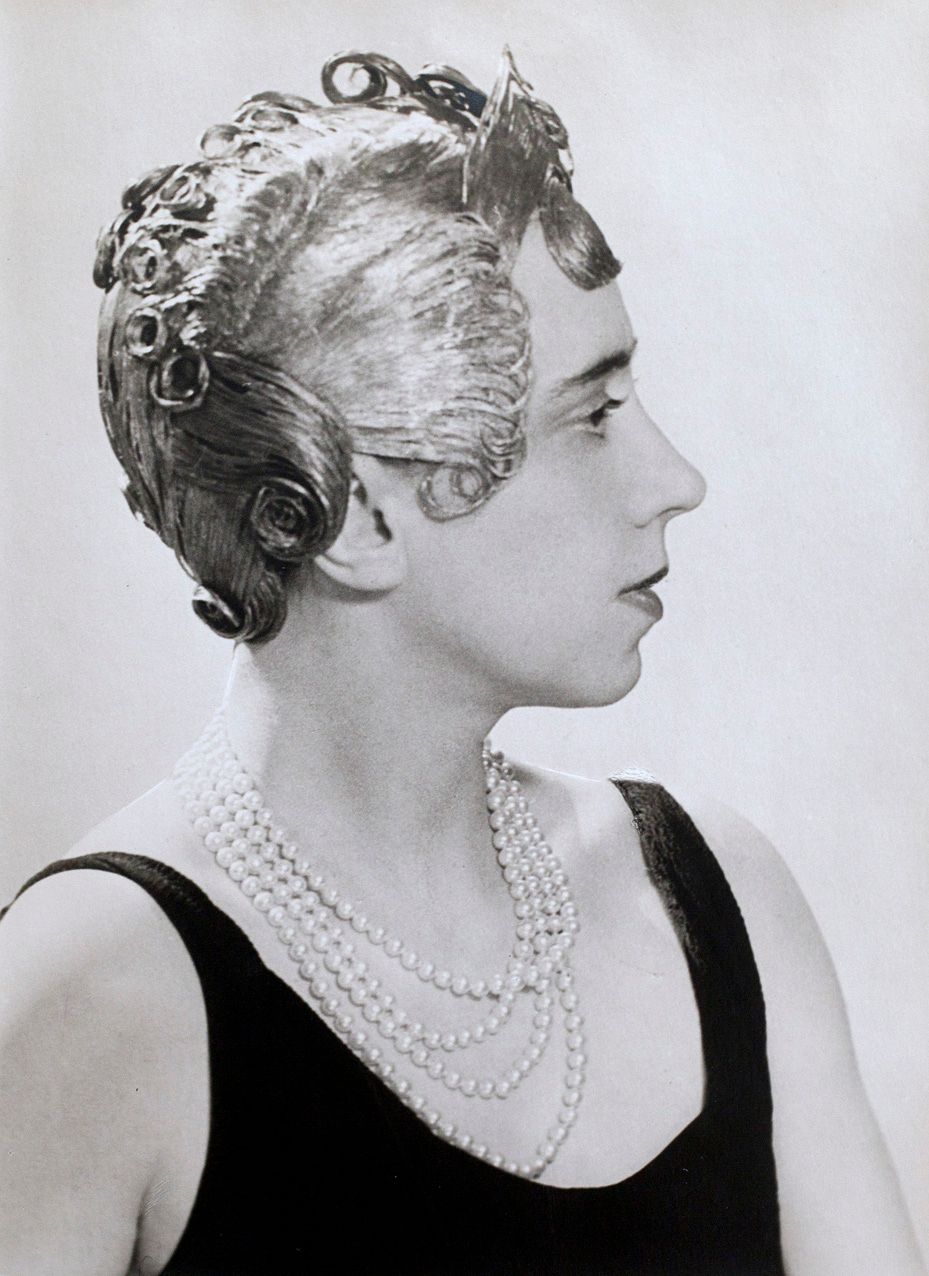
"In the world of art you felt understood and supported, as opposed to the cruel and boring world in which dresses were made simply to sell" - Elsa Schiaparelli, Shocking Life (1954).
Everything in his life revolved around the Shock - to impact -, taken from his surname and his nickname in Paris: Schiap. An avant la lettre artist, always surrounded by the most innovative creators of the 20th century, and like Balenciaga, she created an exclusive fabric and color -shocking pink-, sometimes labeled as the forgotten woman in the history of fashion, or the silent one inspiration of numerous contemporary designers. Elsa Schiaparelli (Rome, 1890 - Paris, 1973) was a rarity in her time, the thirties and forties, she closed her workshop in 1954. Pioneering, daring, extravagant, against the grain, not only in making designs that we could see breaking molds on today's catwalks, but he made the division in haute couture disappear between creative innovation and commercial success, creating schemes in the industry - such as collaborations with artists - that still remain as standard.
Schiaparelli's aristocratic background gave him economic security and links with learned and intellectual circles, but over the years that security turned into prison. At just twenty-one years old, she published "Arethusa", an erotic poetry collection for which she would be admitted to a Swiss boarding school, whose stay would end in a hunger strike. And after having been abandoned by her husband after giving birth to her only daughter "Gogo" in the United States, after a few weeks, she begins to work with Gabrièle Bufet-Picabia - art critic and writer, the first wife of Francis Picabia–, who introduced her to the New York Dadaist circle. During this stage, Schiaparelli internalized the concepts of functionality, freedom and comfort so typical of American fashion. Which he will then take with him to Paris.
From his first and accidental design, the 'trompe-l'oeil sweater' or 'artificial sweater', which was a fabric entrusted by Elsa to a seamstress where the neck scarf was integrated into the fabric of the sweater - as a print and not as a separate piece – this way of proceeding denotes his need to innovate and express himself but, above all, to challenge traditional notions of fashion. In this line, it will continue with its first collection 'Pour le Sport', aimed at sportswear, especially highlighting the skirt and trousers 'Jupe-Culotte', worn by the Spanish tennis player Lilí Álvarez at Wimbledon, for which she was criticized to masculinize the piece. Clearly, the criticism had the opposite effect: her designs became more popular and in 1934 the designer appeared in Time magazine, presenting her as an arbiter of ultra-modern haute couture and, at the same time, making her the first fashion designer to appear on the cover.
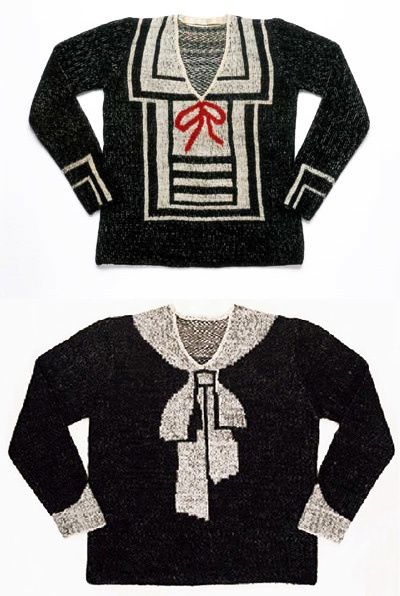 Primer disseny de Schiaparelli 'Trompe l'oeil sweater', 192
Primer disseny de Schiaparelli 'Trompe l'oeil sweater', 192
ART ECOSYSTEM: FROM MAN RAY AND LEONOR FINI TO DALÍ.
In his active years, he managed to collaborate with many artists who embodied his same imaginative freedom, with a fixation on the corporeal, animal and subliminal. He collaborated with American visual artist Man Ray on several photo shoots. Also in several pieces designed by Elsa herself, based on sketches of faces that filmmaker Jean Cocteau drew for her on request. In a way, it pays tribute to Pablo Picasso by being inspired by a photograph taken by Man Ray of two hands painted by the artist from Malaga, from there an idea was created that he would later expand: gloves with nails on the outside and that would return brand icon; later and by chance, Picasso paints the wife of the poet Paul Eluard who was using Schiaparelli.
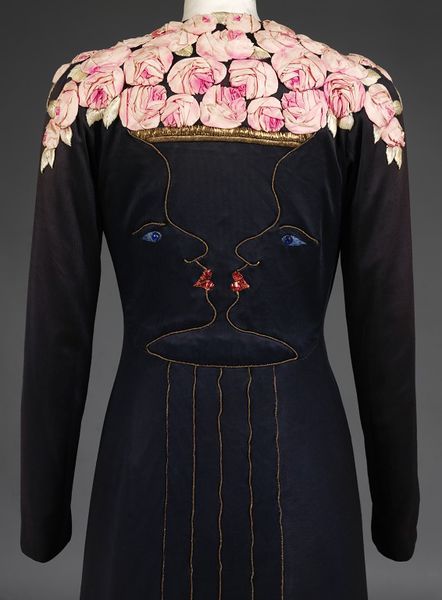 Abric de nit, dissenyat per Elsa Schiaparelli i Jean Cocteau, 1937, Londres
Abric de nit, dissenyat per Elsa Schiaparelli i Jean Cocteau, 1937, Londres
His 'Shoking' perfume was designed by Argentinian artist Leonor Fini, who was inspired by Mae West's mannequin, whom Schiapareli dressed in the film 'Everyday's a Holiday'. From 1935 to 1938, Alberto Giacometti created many different pieces of jewelry alongside Elsa, which he would put on jackets, such as buttons with mythological images. But, without a doubt, his most remarkable and memorable collaboration was with the person with whom he most shared a vision: Salvador Dalí. Dalí in his infinite eccentricity and need to create, is no stranger to fashion design, in fact he could not have been more connected to haute couture and its most important exponents of the 30's, with designers Schiaparelli and Chanel explaining - him as an inspiration to his designs and a personal friend; without even knowing it, Dalí also had the designer who would revolutionize fashion in 1947, the not yet ventured into couture Christian Dior, as his gallerist in Paris in 1931.
 Wallis Simpson a ‘Le Robe Homard’ fotografiada per Cecil Beaton per a Vogue
Wallis Simpson a ‘Le Robe Homard’ fotografiada per Cecil Beaton per a Vogue
His occasional encounter with fashion design allowed Dalí to take his imagery and surrealism to another level. When, after having created the Telèfon-Llagosta, a symbol that began to appear around the Catalan artist, either on the head of his wife Gala or on a model's belly, the collaboration begins with Schiaparelli in the making of a piece, a request from the dressmaker that was very out of the ordinary, since collaborations between artists and designers did not happen, let alone allowing the artist to work in a workshop. It was a collaboration as unusual as its participants, resulting in the 'Le Robe Homard' Lobster Dress, worn by Wallis Simpson, Duchess of Windsor, for Vogue; it was a scandal, a woman of royalty, wearing such an elegant piece in its construction and materials, with such a comical and erotic design in the most important fashion magazine on an international scale.
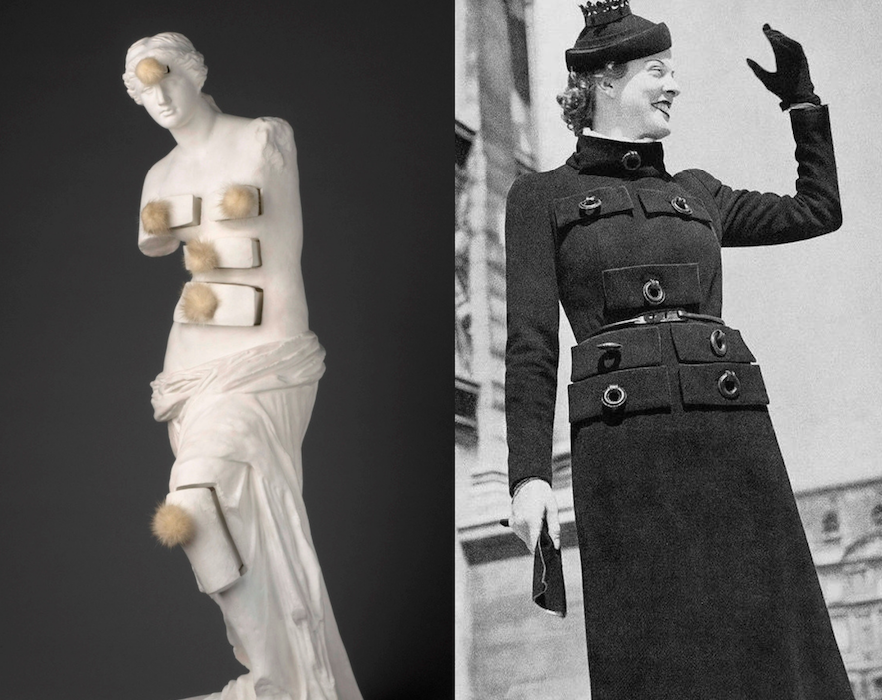 'Venus de Milo amb Calaixos', 1936 i 'Vestit de Calaixos', 1936
'Venus de Milo amb Calaixos', 1936 i 'Vestit de Calaixos', 1936
Elsa was later inspired by Dalí's Venus de Milo with Drawers, Anthropomorphic Desk and The Fiery Giraffe to create a nightgown featuring drawer-shaped pockets on the front and denoting a skeletal figure, in the width of its shoulder pads and the narrowness of the waist. A figure that he would later raise alongside Dalí, in his next collaboration for La Col·lección Circ 1938, probably the one that remains most current in his design. The 'Skeleton Dress', the jewel in the crown of the Circ Collection which uses a quilting technique, to enhance a relief that appears to be the skeleton under the dress, highlighting the ribs, pelvis, clavicle and spine, a of his most striking visual creations: he makes his model look like an incarnation of a Dalí work.
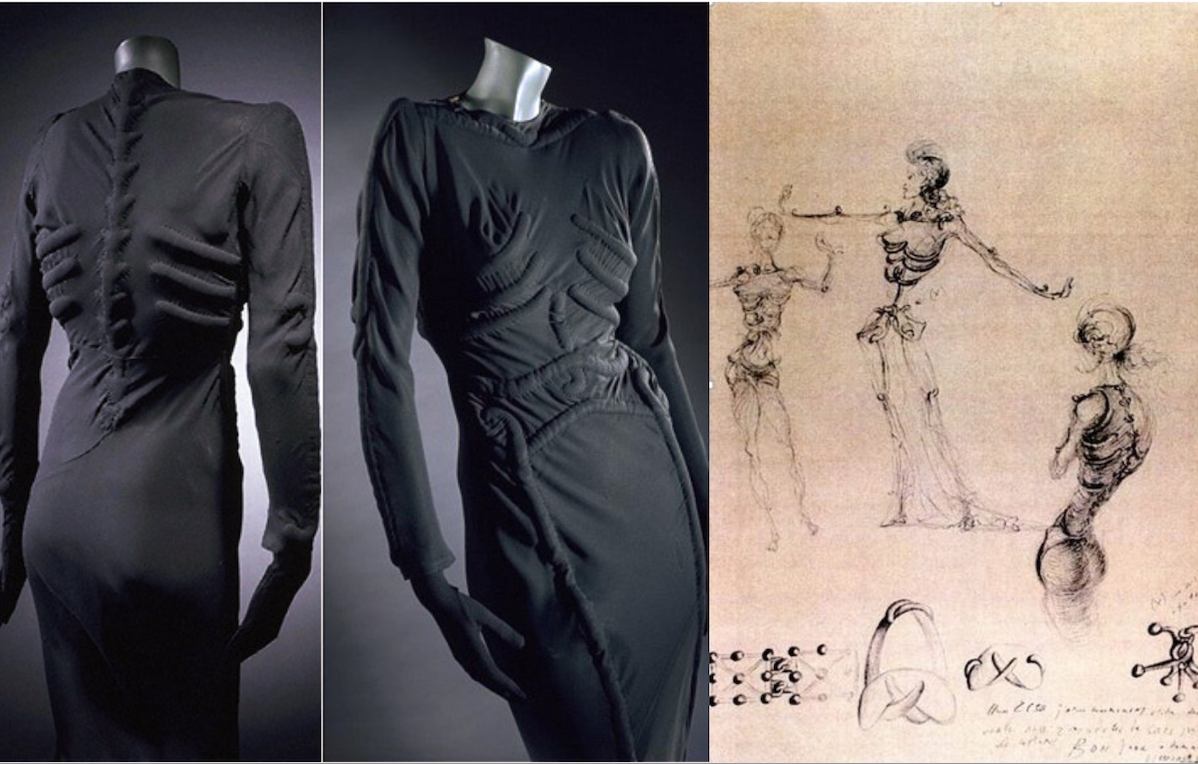 ‘Vestit Esquelet’ Disseny per Elsa Schiaparelli i Salvador Dalí, Col·lecció ‘Le Circus’ Estiu 1938
‘Vestit Esquelet’ Disseny per Elsa Schiaparelli i Salvador Dalí, Col·lecció ‘Le Circus’ Estiu 1938
As part of the same collection, in which Dalí contributed everything from the design of buttons in the shapes of horses and acrobats to the printed fabrics that Schiaparelli would use in her dresses, the collaboration 'The Dress Torn'. This dress stands out for its fabric printed with rip and tear designs, again using the 'trompe-l'oeil' visual effect of Elsa's first design. In addition, it introduces an innovation for the designer, being one of the first to adopt the rayon-viscose fabric for its manufacture. The design of the torn fabric on the dress, by Dalí, evokes his painting 'Three young surrealists holding in their arms the skins of an orchestra' (1936), where a woman with a floral face and torn flesh is presented. The silhouette of the dress recalls the painting 'Necrophilic Spring' (1936) by the artist from Emporda, a piece that belonged to the designer at the time. This dress fits the body like a second skin from another world. The veil that accompanies the dress cascades over her tight shape, evoking an almost religious modesty. The veil does not have the tear printed on the fabric, but is sewn onto itself, with strips hanging down creating a stark contrast to the tears running through it and revealing flashes of Schiaparelli's 'Shocking pink', hinting at the flesh beneath . More than simple wear and tear on the fabric, the appearance is of torn leather.
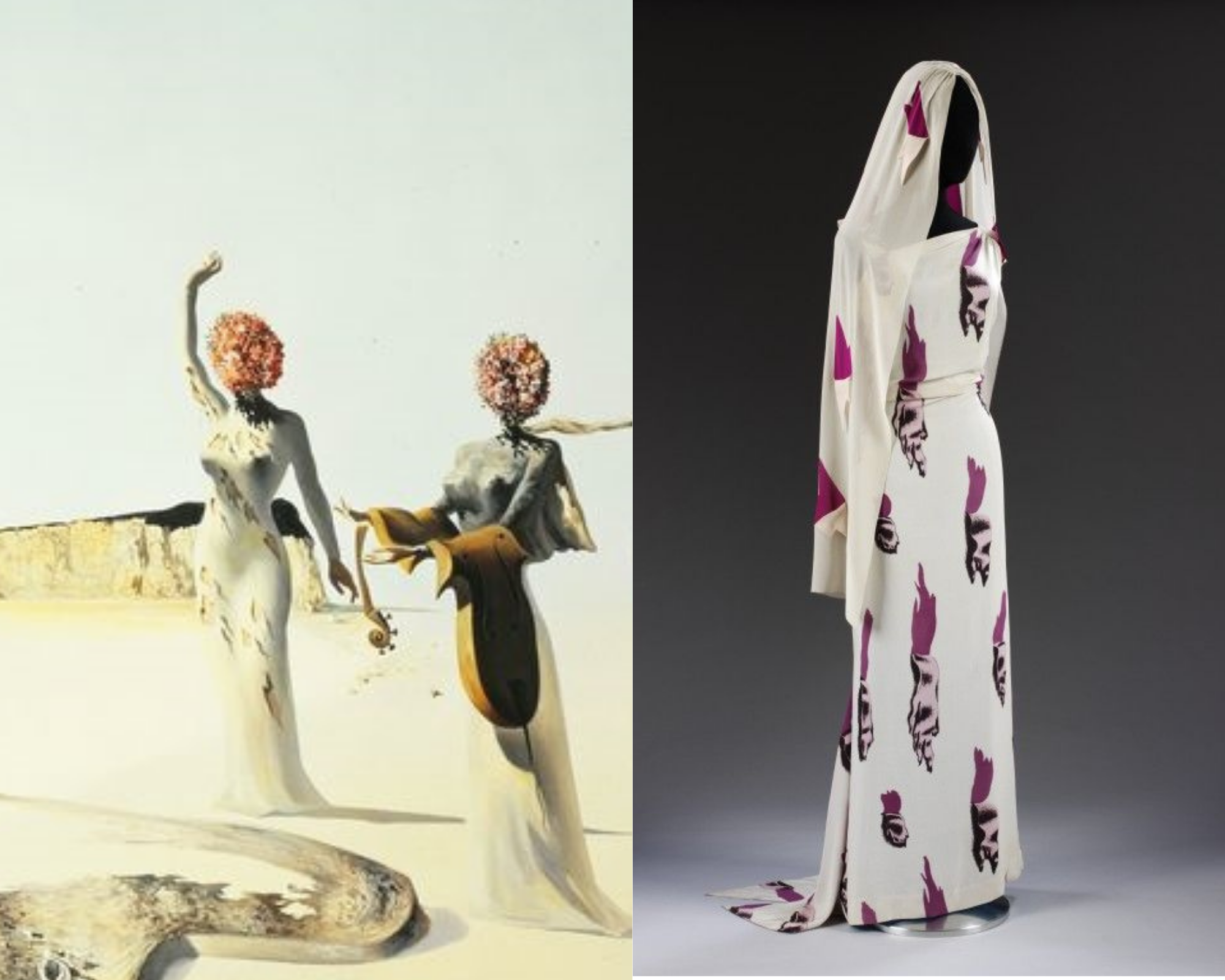 'Vestit Esquinçat' Disseny per Elsa Schiaparelli i Salvador Dalí, Col·lecció 'Le Circus' Estiu, 1938
'Vestit Esquinçat' Disseny per Elsa Schiaparelli i Salvador Dalí, Col·lecció 'Le Circus' Estiu, 1938
The 'Skeleton Dress' and 'Torn Dress' belonged to the actress Ruth Ford, sister of the Surrealist poet Charles-Henri Ford, a gift from Dalí's patron, Edward James, a great supporter of the Surrealist movement.
Together, Dalí and Schiaparelli created many more works, including jewelry, perfumes, and even a hat that looks like a shoe placed upside down on the wearer's head. With these pieces, they reflected their transgressive spirit, showing their affinities without the intervention of the rational mind.
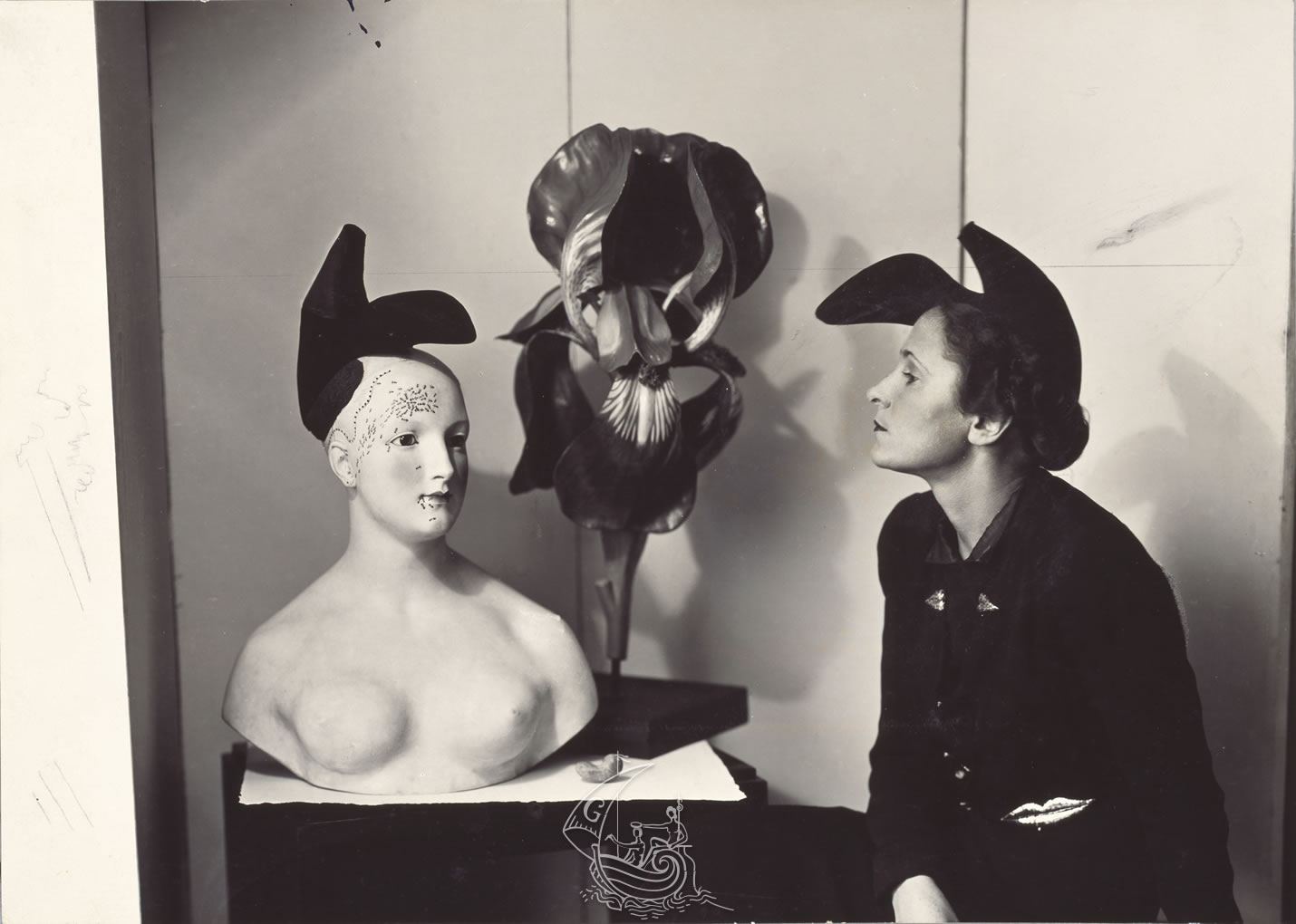 Gala al costat d'una versió del 'Bust de dona retrospectiu', tots dos amb el 'Barret-sabata' dissenyada per Schiaparelli i Dalí, 1937-38
Gala al costat d'una versió del 'Bust de dona retrospectiu', tots dos amb el 'Barret-sabata' dissenyada per Schiaparelli i Dalí, 1937-38
NEW ERA: THE REVIVAL OF SCHIAPARELLI.
Everyone who considered themselves important in the 1930s was wearing Schiaparelli: from Joan Crawford to Marlene Dietrich. Currently, from Anne Hathaway to Rosalía, thanks to the new face of Schiaparelli and its creative director Daniel Roseberry, who arrives at this house in 2019 and quickly revives that feeling of innovating and provoking that defined the brand, with wacky reasons , unique silhouettes and subversive details. Daniel gives us a taste of what Elsa's dream world would look like today.
Madame Schiaparelli adored broad shoulders on jackets, later exaggerated the size of the sleeves and made the zipper an ornamental element. Roseberry takes note of all this and returns it to the dominant in the brand, to increase the importance that Elsa gave to small details, how she turned accessories into small pieces of art, how she turned her bags into new separate spaces from the world that surrounds them With all these examples, Daniel increases and relaunches the identity of the new Schiaparelli House, which, like the old designer, caused a furore from day one. On this occasion, Daniel sat at a desk in the middle of the catwalk of his first show and drew in real time the sketches of the looks that the models walked around him. The Schiaparelli house led by Roseberry does not dilute its haute couture designs in its ready-to-wear so that they are easily consumable by the masses, but they follow the same line of haute couture with ties made from hair woven in braids, bags with faces and, more recently, adding the rotary dial of an old telephone to some jackets, referencing the first collaboration between Elsa and Dalí.
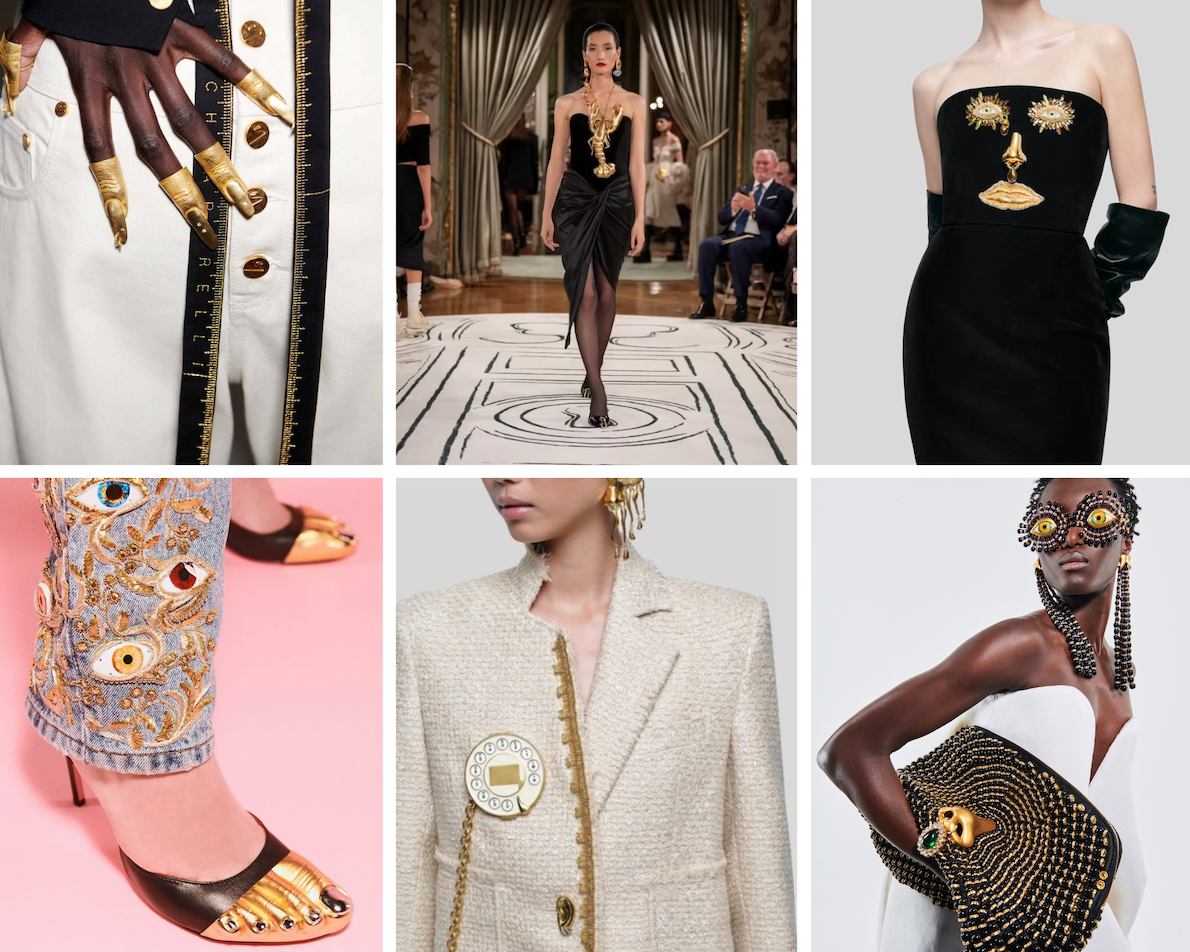 Maison Schiaparelli en actualitat, dissenyat per Daniel Roseberry
Maison Schiaparelli en actualitat, dissenyat per Daniel Roseberry
So Elsa Schiaparelli's legacy is not her technique, nor her silhouette or even her iconography, it is her rebellious attitude towards life and creative action, it is the surrealism in her design, since from the hats to the tips of the feet bathed in gold outside the heels, is to go against the trends, to have shown that elegance is not minimalist, that beauty is not always the purpose of fashion and that the purpose of the Maison Schiaparelli was and continues to be the originality.





